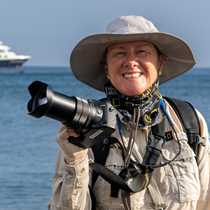Genovesa Island
A collapsed caldera; a deep bay (over 600 feet in places); flying dinosaurs overhead; guano smell all around; steel gray cliffs all around us, with a fringe of green on top; words written on the wall, slowly but surely disappearing beneath a layer of bird-droppings.
Genovesa has no terrestrial reptiles; they never drifted this far north from the other islands or west from the mainland. As a result, there are soft, hairy cacti inhabiting this island since there is no need for sharp defenses against the large herbivores that never arrived. Marine iguanas are the only reptiles here; small, dark and inconspicuous. They are not the stars of the show here. Great frigatebirds, red-footed boobies, large cactus finches, Galápagos doves, short-eared owls, Galápagos storm petrels, warbler finch, Nazca boobies, yellow-crowned night herons, striated herons…and there are more!
There is a paucity of nesting material here, despite the appearance of lush growth. Every fresh twig and stick is sought after and fought over. Old twigs from nests past aren’t used – too big a chance of parasites still attached. The front rows of bushes off the beach are kept trimmed and low. In all my years of visiting this amazing island, the bushes haven’t gown any taller.
Bright red gular sacks were shaken and stirred against a chest of black feathers and wings of metallic greenish black; the backdrop is verdant green filled with hollow warbling and drumming. The great frigatebirds are in the throes of courtship (not all males will be successful, but all available females will). Drama played out in front of us this morning in the frigatebird world: twigs stolen, nest usurped, males and females both instinctively knowing that it is a no-holds-barred struggle to get their genes into the next generation.
Red-footed boobies sat soft and velvety in mangroves, peering out at us from turquoise-rimmed black eyes, blue bills bordered pink and black. The red is in their legs and webbed feet, with claws grasping branches. Something should have seemed silly about all these colors in one animal, but was awesome instead.
Snorkeling was great (in my opinion it always is, here in Galápagos). Gigantic bump-headed parrotfish, Moorish idols, sunset wrasses, and a few lucky people saw hammerhead sharks below in the depths (they are very shy). A school of golden rays also passed, autumn leaves in the tropics.
Our last kayaking opportunity had us paddling around the base on the cliff encompassing Darwin Bay. About 100 feet high, the nooks, crannies and fissures provide protected nesting sites for red-billed tropicbirds, swallow-tailed gulls, Galápagos shearwaters, and night herons, all of which we cruised by without disturbing them in the least. Even a small colony of Galápagos fur seals hang out on the inside of the bay, and Pacific green sea turtles were spotted a couple of times popping their heads up out of the flat smooth sea surface.
Mid-afternoon had everyone going ashore again to visit different areas, the opposite of what was visited in the morning; so one group went to the beach while the other climbed the fissure called “Prince Philip’s Steps.” The top is another wonderland of red-footed boobies and frigates, but with more nests of the Nazca booby, some with chicks. This species is notorious for the practice of “siblingcide” between newly hatched chicks of the same nest. The older pushed the younger out of the nest until even the parent doesn’t recognize it as one of its own.
Genovesa is a battleground for survival. Any idea that people have of Galápagos as a paradise is usually replaced with a cruel reality at this point. Short-eared owls feast on Galápagos storm petrels along the outer cliffs. Life is not easy, but the result of millions of years of intense competition and selection have given us a beautiful world with varied life-forms that amaze the eye and inspire admiration for the incredible variety of strategies that have evolved to evade predation and starvation while at the same time passing one’s genes onto the next generation.




